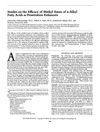DMSO
Research
20 / 1000+ resultsresearch Investigation of the Mitigation of DMSO-Induced Cytotoxicity by Hyaluronic Acid Following Cryopreservation of Human Nucleus Pulposus Cells
Hyaluronic acid reduces cell damage from DMSO in preserved human cells.
research Topical Treatment Using Amphotericin B and DMSO for an Atypically Located Equine Cutaneous Pythiosis
Topical treatment with amphotericin B and DMSO effectively healed a horse's skin infection.
research Enhanced Skin Penetration of Finasteride Loaded DMSO-Liposomes for the Treatment of Androgenic Alopecia: Comparison with Conventional Liposomes
DMSO-liposomes improve finasteride delivery for hair loss treatment.
research Effect of Modified Aloe Vera Gel in the Treatment of Hepatotoxicity and Alopecia Induced by CCL and DMSO in Mice
Modified Aloe vera gel helped reduce liver damage and promote hair regrowth in mice.
research The Effect of Dimethyl Sulfoxide on Percutaneous Absorption: A Mechanistic Study, Part III
DMSO causes reversible swelling in hair but has a complex, less reversible effect on skin.
research Retinoic Acid And Dimethyl Sulfoxide Promote Efficient Delivery Of Transgenes To Mouse Skin By Topically Transdermal Penetration
Retinoic acid and DMSO improve gene delivery to mouse skin for potential hair and skin disease treatment.
research Effect of Incubation with Dimethyl Sulfoxide on the Mitotic Cycle of Rabbit Dermal Papilla Cell Culture
A 5% DMSO and 5% BSA mix best preserves rabbit dermal papilla cells during cryopreservation.

research Cryopreservation Of Engineered Hair Follicle Germs For Hair Regenerative Medicine
DMSO and microfinger devices show promise for preserving hair grafts for hair loss treatments.
research In Vitro and In Vivo Study of Dye Diffusion into Human Skin and Hair Follicles
Dyes can penetrate human skin and hair follicles up to 1.2 mm deep and the sebaceous gland can store dye; Indocyanine Green lotion was made for safe dyeing and monitoring.

research Doxorubicin-Induced Hair Loss in the Angora Rabbit: A Study of Treatments to Protect Against Hair Loss
Vitamin E in the diet might help protect against hair loss caused by the chemotherapy drug doxorubicin in rabbits.
research Extensive Hair Shaft Growth After Mouse Whisker Follicle Isolation, Cryopreservation, and Transplantation in Nude Mice
Cryopreserved mouse whisker follicles can grow hair when transplanted into nude mice.
research Cryopreservation of Hair-Follicle Associated Pluripotent Stem Cells Maintains Differentiation and Hair-Growth Potential
Freezing and storing special stem cells from hair follicles keeps their ability to grow hair and turn into different cell types.

research Studies on the Efficacy of Methyl Esters of N-Alkyl Fatty Acids as Penetration Enhancers
Methyl caprate greatly increases drug absorption through the skin and is better than other enhancers.
research In Vitro Release of Zinc Pyrithione from a Shampoo Base and the Effects of Various Additives on Its Release Rate
Additives like ethanol and propylene glycol increase the release of zinc pyrithione from shampoo.

research Alopecia in Laboratory Animals Induced by a Polyampholyte, Polyethylene Alanine
Polyethylene alanine caused hair loss in young lab animals but not in adults, with hair regrowth occurring within 20 days.

research Peer Review of 'Melatonin Increases Growth Properties in Human Dermal Papilla Spheroids by Activating AKT/GSK3β/β-Catenin Signaling Pathway'
Melatonin may improve hair growth by affecting certain cell signaling pathways.
research Effects of Essential Oil from Coicis Semen on Hair Growth in Human Dermal Papilla Cells
ECS may help treat hair loss by promoting hair cell growth.
research Efficacy of Topical Vorinostat in the Reversal of Alopecia Areata
Topical Vorinostat shows promise for treating alopecia areata by promoting hair regrowth.

research Povidone-Iodine Nail Solution Is Active in Treating Chemotherapy-Associated Paronychia
Povidone-iodine nail solution effectively treats nail infections caused by chemotherapy.
research Effects of Topically Applied Platycarya Strobilacea S. et Z. Extract on Hair Growth in C57BL/6 Mice
Platycarya strobilacea extract significantly improves hair growth and follicle health.